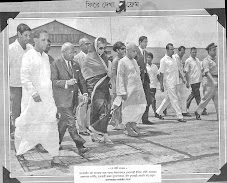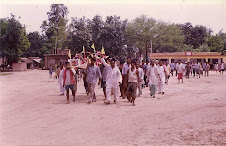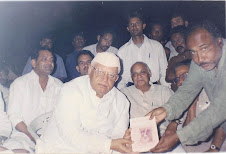From: Press Information Bureau Ministry of I&B <pib.kolkata@gmail.com>
Date: Thu, Jul 15, 2010 at 2:21 PM
Subject: Releases...........pt1
Press Information Bureau
Government of India
* * * * * *
Ministry of Environment and Forests
Threatened Plants of India – Species Considered Extinct
New Delhi: July 15, 2010.
Species like Syzygium bourdillonii, Hubbardia heptaneuron Bor and Vanda wightii Reichb.f., once considered extinct, have recently been rediscovered from the areas previously unexplored. It may be noted that the lists of threatened species is never static and the conservation status of a plant may vary for several reasons, one of them being the observability There is, therefore, every possibility that intensive and extensive plant explorations in hitherto unexplored areas of the country may result into rediscovery of many more species which are considered extinct today.
FLORA OF INDIA – SPECIES CONSIDERED EXTINCT
| Sl. no. | Name of the species | Family | Distribution |
| 1. | Isoetes dixitii Shende | Isoetaceae | Maharashtra |
| 2. | Isoetes sampathkumarnii L.N.Rao | Isoetaceae | Karnataka |
| 3. | Selaginella cataractarum Alston | Selaginellaceae | Tamil Nadu |
| 4. | Lastreopsis wattii (bedd.) C.Chr. | Dryopteridaceae | Manipur |
| 5. | Ophiorrhiza brunonis Wight & Arn. | Rubiacea | Karnataka, Kerala, Tamil Nadu |
| 6. | Ophiorrhiza caudata C. Fischer | Rubiacea | Kerala |
| 7. | Ophiorrhiza radicans Gardn | Rubiacea | Kerala |
| 8. | Wendlandia angustifolia Wight | Rubiaceae | Tamil Nadu |
| 9. | Sterculia khasiana Deb | Sterculiaceae | Meghalaya |
| 10. | Carex repanda C.B. Clarke | Cyperaceae | Meghalaya |
| 11. | Eragrostis rottleri Stapf | Poaceae | Tamil Nadu |
| 12. | Eriochrysis rangacharii C.E.C.Fischer | Poaceae | Tamil Nadu |
| 13. | Dipcadi concanense (Dalz.) Baker | Liliaceae | South India |
| 14. | Dipcadi reidii Deb & Dasgupta | Liliaceae | Western Himalaya |
| 15. | Urginea polyphylla Hook.f. | Liliaceae | Deccan Plateau |
| 16. | Calanthe whiteana King & Pantl. | Orchidaceae | Sikkim |
| 17. | Pleione lagenaria Lindl. | Orchidaceae | Meghalaya |
| 18. | Corypha taliera Roxb. | Arecaceae | West Bengal |
| 19. | Hedychium marginatum C.B. Clarke | Zingiberaceae | Nagaland |
[Source: Red list of Threatened Vascular Plants of India. ENVIS Centre, BSI, Howrah, 2003]
kp/dk/kol/13:47 hrs.
Press Information Bureau
Government of India
* * * * * *
Ministry of Home Affairs
Amendment of provisions under Section 13 of the Arms Act, 1959 approved
New Delhi: July 15, 2010.
The Union Cabinet today approved the amendment of provisions under Section 13 of the Arms Act, 1959 for (i) specifying a period of sixty days for the purpose of police report required under sub-section (2) of section 13 of the Act and (ii) deletion of proviso to sub-section (2A) of section 13 of the Act. The Cabinet also approved the introduction of the Arms (Amendment) Bill, 2010 in the Parliament.
The proposed amendments will obviate chances of issuing arms licences to persons whose antecedents are not bonafide, and ensure receipt of police verification report within a period of sixty days. The licensing authority will be obliged to take into consideration the report of the police authorities before grant of an arms licence in each case, with the deletion of the proviso to Section 13 (2A) of the Arms Act, 1959.
Under Section 3 of the Arms Act, 1959, it is essential to obtain an arms possession licence issued by a competent licensing authority by any person for acquisition, possession or carrying any firearms or ammunition.
Section 13 of the Arms Act, 1959 contains provisions relating to grant of arms licences by the licensing authority concerned. On receipt of an application, the licensing authority is required to call for a report from the officer in-charge of the nearest police station and such officer is required to send his report about the bonafide of the antecedent of the applicant to the licensing authority, within the prescribed time. The licensing authority is required to take a decision whether to grant or to refuse to grant the arms possession licence, based on the report of the police authorities and subject to fulfilment of other conditions stipulated under the Arms Act. However, there is a proviso to Section 13 (2A), which empowers the licensing authority to grant an arms licence where the report of the police authorities has not been received within the prescribed time.
The quantum of prescribed time referred to in Section 13 of the Arms Act, 1959 has not been specifically defined under the said Act. This being so, the chances of invoking proviso may be easy, which may lead to grant of an arms licence to a person whose antecedents, may not be clear.
Considering the importance of the police verification report in the grant of arms licences to any person, it has been decided to delete the proviso to Section 13 (2A) of the Arms Act, 1959 and prescribe a period of 60 days for the police authorities to send their report, to obviate chances of discretion being used by the licensing authority to issue any arms licence without police verification report.
sh/lv/dk/kol/13:47 hrs.
Press Information Bureau
Government of India
* * * * * *
Ministry of Law & Justice
Continuation of the existing scheme of central assistance for Fast Track Courts
New Delhi: July 15, 2010.
Cabinet Committee on Economic Affairs today approved the continuation of the scheme of central assistance for Fast Track Courts for a further period of one year upto 31st March 2011. Central assistance to the States will be provided for 1562 Fast Track Courts @ Rs.4.80 lakh per court for the year 2010-11. A budget provision of Rs.75.00 crore has been made for the scheme in the budget of the current financial year.
As per the information received from the State Governments/Registries of the High Courts, 28.38 lakh cases have been disposed off out of 35.02 lakh cases transferred to Fast Tract Courts since inception.
On the basis of the recommendation of the Eleventh Finance Commission, the Ministry of Finance had sanctioned an amount of Rs.502.90 crore for establishment of 1734 Fast Track Courts to expeditiously dispose of long pending cases in the Sessions courts and long pending cases of undertrial prisoners. The scheme was for a period of five years from 2000-2005. After the expiry of the term of the scheme on 31st March, 2005, Government accorded its approval for the continuation of 1562 Fast Track Courts that were operational as on 31st March 2005 for a further period of five years i.e. upto 31st March, 2010 with a provision of Rs.509 crore.
sh/lv/dk/kol/13:48 hrs.
Press Information Bureau
Government of India
* * * * * *
Ministry of Finance
Government to Renovate/Restore Existing Tagore Auditoria and Construct New Tagore Complexes to Commemorate 150th Birth Anniversary of Rabindranath Tagore
New Delhi: July 15, 2010.
Government of India will renovate or restore the existing Tagore Auditoria and will construct new Tagore Complexes in important cities which do not have such complexes. This was decided in the Second Meeting of the National Implementation Committee on commemoration of 150th Birth Anniversary of Rabindranath Tagore, held under the Chairmanship of Union Finance Minister, Shri Pranab Mukherjee in Delhi yesterday.
The meeting was attended by Km. Mamata Banerjee, Minister of Railways, Smt. Ambika Soni, Minister of I&B, Shri Kapil Sibal, Minister of HRD, Prof. Namwar Singh, Smt. Sushma Nath, Secretary (Expenditure) and Shri Jawhar Sircar, Secretary (Culture) among others.
The Committee also approved the proposal regarding undertaking of restoration works in Visva-Bharati i.e. of paintings, sculptures, bronze casts. Other decisions taken in the aforesaid meeting include that NIC would bring out unique book on the paintings of Gurudev Rabindranath Tagore while Ministry of HRD will examine and work on setting-up of Liberal Arts University/Liberal Arts Institute as also a Centre of Tagore Studies in Indian Institute of Advanced Studies (IIAS), Shimla. It was also decided that Ministry of Railways will start Sonar Tari Express which will reach Dhaka on 8th August 2010 to mark the death anniversary of Rabindranath Tagore. Besides, Railways will also set-up two museums to commemorate 150th Birth Anniversary of Rabindranath Tagore. A proposal to set-up 8 Zonal Level Tagore Commemoration Committees for Cultural Programmes proposed by non-Governmental Organisations was also approved by the aforesaid Committee.
dsm/by/kp/gn/dk/kol/13:48 hrs.
Press Information Bureau
Government of India
* * * * * *
Ministry of Finance
Acquisition of State Bank of Indore by State Bank of India approved
New Delhi: July 15, 2010.
The Union Cabinet today approved the acquisition of State Bank of Indore by State Bank of India (SBI) and also accorded `in-principle' approval to introduce a Bill in the Parliament for making consequential amendments in the State Bank of India (Subsidiary Banks) Act, 1959, to remove references of State Bank of Indore.
Acquisition of State Bank of Indore by SBI would allow economies of scale in terms of footprint, manpower and other resources. The branches of the State Bank of Indore, including 83 located at different centers outside Madhya Pradesh and Chattisgarh, can be conveniently controlled from the Local Head Offices controlling SBI branches in the respective States. This will result in substantial cost savings, as it will cut the avoidable overhead cost of running two Regional Offices at New Delhi and Mumbai, which presently control the branch network of State Bank of Indore in the States other than Madhya Pradesh and Chattisgarh.
Acquisition of State Bank of Indore will also help in spreading its credit risk as the concentration risk to which the Bank is exposed, can be spread over larger base of SBI. Besides, keeping in view the growing economy, State Bank of Indore would require larger equity capital to support a growing balance sheet. In the event of its acquisition, the increased capital requirement can be taken care of by SBI. Capital can be raised cost effectively by SBI instead of capital to be raised by State Bank of Indore at higher rates.
BACKGROUND:
After acquisition of State Bank of Saurashtra by SBI, the issue of acquisition of Associate Banks of State Bank of India by SBI has been engaging the attention of SBI. SBI is facing a situation where most of the branches of SBI and those of State Bank of Indore are competing for the same business in the same market, under the same brand. This has prevented SBI from fully exploiting its brand equity for driving business growth.
sh/lv/dk/kol/13:48 hrs.
Press Information Bureau
Government of India
* * * * * *
Planning Commission
Comprehensive and Integrated Socio-Economic Development Project under the New Land Use Policy (NLUP), Government of Mizoram
New Delhi: July 15, 2010.
The Cabinet Committee on Economic Affairs has approved the "Comprehensive and Integrated Socio-Economic Development Project under the New Land Use Policy (NLUP) of Government of Mizoram" within the ceiling of Rs.2873.13 crore [Rs.1000.84 crore as CSS(Centrally Sponsored Schemes); Rs.1526.14 crore as ACA (Additional Central Assistance)/SPA (Special Plan Assistance) and Rs.346.15 crore as beneficiary contribution] subject to the following stipulation:
(a) The unit costs of the activities would be worked out and approved by the Sector Specific Technical Committees at the State level which would have a representative from the Ministry concerned, before the programme starts;
(b) Requisite approvals and clearances would be obtained for individual components of the proposal as may be required
(c) Provisions will be made for adequate capacity building for obtaining technical expertise and for marketing and other linkages, as well as for greater value addition;
(d) Forest/environment clearances for implementation of the project would be obtained where necessary;
(e) In the event of upward revision in the norms of CSSs/Government funding or the Government of Mizoram leveraging more funds from other CSSs/CSs(Central Schemes), the share for ACA/SPA will be correspondingly reduced.
The programme seeks to benefit 1,20,000 families over a period of five years for select livelihood activities.
All Jhumia families will switch over to permanent livelihood activities having ownership of land access to link roads, irrigation, water harvesting and would get remunerative prices for produces. A judicious mix of agri-horticultural activities, animal husbandry, fisheries, agro-forestry, micro-enterprise etc is expected to increase income by 7-10 times compared to income from jhuming at present. The overall growth of economy will increase from about 6% to 16% in 10 years' time.
The main components of the project are (i) schematic (activity specific) beneficiary component and (ii) infrastructure component. The livelihood activity would include land reclamation, agri-horticultural and plantation crops, medicinal plants, animal husbandry, fishery, sericulture, bamboo plantation and micro-enterprise. For management of the project there will be a 3-tier structure, namely, the State Level NLUP Apex Board (with a functional team as the NLUP Implementing Board), District Level NLUP Committees and Village Level NLUP committees.
The Village Level Committees would prepare land use plan, selection of beneficiaries, allotment of land to beneficiaries, preparation of village level project and action plan. This would get incorporated in the district plans and the State Plan which would be implemented by the line department concerned.
sh/lv/dk/kol/13:50 hrs.
Press Information Bureau
Government of India
* * * * * *
Ministry of Communications & Information Technology
DoT Sets up a Search Cum Selection Committee to be set up for Appointment of CMDs for BSNL/MTNL
Selection to be Completed Within a Month
New Delhi: July 15, 2010.
The appointment of CMDs of MTNL and BSNL will be done through a Search-cum-Selection Committee headed by the Cabinet Secretary. The Minister of Communications & Information Technology has approved the constitution of the Search-cum-Selection Committee with the following members:-
i. Cabinet Secretary - Chairman
ii. Secretary, Deptt. of Personnel - Member
iii. Secretary, Deptt. of Telecom - Member
iv. Prof. Ashok Jhunjunwala, IIT, Chennai - Member
v. Prof. Sameer Barua, IIM, Ahmedabad - Member
vi. Prof. N. Balakrishnan, IISc. Bangalore - Member
The Selection process will be completed within a month.
This is in view of the incorrect reports in a section of the media.
sp/as/dk/kol/13:50 hrs.
Press Information Bureau
Government of India
* * * * * *
Ministry of Environment and Forests
Threatened Plants of India
New Delhi: July 15, 2010.
Jharkhand
1. Jasminum strictum Haines (Oleaceae) - CR
Orissa
2. Unona eucincta Bedd. ex Dunn (Annonaceae) – EN
Punjab
3. Ceropegia bulbosa Roxb. (Asclepiadaceae) – VU
Bihar
4. Carum villosum Haines (Apiaceae) - EN
5. Erythrina herbacea L. (Leguminosae) – EN
Daman & Diu
7. Ceropegia fantastica Sedgw. (Asclepiadaceae) - EN
8. Hyphaene thebica (L.) C. Martius (Arecaceae) – EN
Gujarat
9. Ceropegia odorata Nimmo ex Hook.f. (Asclepiadaceae) - EN
10. Hyphaene thebica (L.) C. Martius (Arecaceae) – VU
11. Tephrosia jamnagarensis Santapau (Leguminosae) - EN
Rajasthan
12. Ceropegia odorata Nimmo ex Hook.f. (Asclepiadaceae) – EN
13. Commiphora wightii (Arn.) M.M. Bhandari (Burseraceae) - CR
14. Dicliptera abuensis Blatt. (Acanthaceae) - EN
15. Strobilanthes hallbergii Blatt. (Acanthaceae) - EN
Goa
16. Aspidopterys canarensis Dalzell (Malpighiaceae) - CR
17. Begonia trichocarpa Dalzell (Begoniaceae) - EN
18. Ceropegia fantastica Sedgw. (Asclepiadaceae) - EN
19. Discospermum sphaerocarpum Dalzell ex Hook.f. (Rubiaceae) - EN
20. Habenaria multicaudata Sedgw. (Orchidaceae) - EN
21. Oberonia brachyphylla Blatt. & McCann (Orchidaceae) - VU
22. Paracaryopsis coelestina (Lindl.) R.R. Mill (Boraginaceae) - VU
23. Wiesneria triandra (Dalzell) Micheli (Alismataceae) – EN
West Bengal
24. Acampe rigida (Buch.-Ham. ex J.E.Sm.) P.F.Hunt (Orchidaceae) – EN
25. Calamus inermis T. Anderson (Arecaceae) – VU
26. Christopteris tricuspis (Hk.) Christ (Polypodiaceae) -EN
27. Cissus spectabilis (Kurz) Planch. (Vitaceae) - EN
28. Dendrobium pauciflorum King & Pantl. (Orchidaceae) - EN
29. Dryopteris gamblei (Hope) C. Chr. (Dryopteridaceae) – VU
30. Elatostema nasutum Hook.f. (Urticaceae) – EN
31. Trias oblonga Lindl.(Orchidaceae) -EN
IUCN categories abbreviations used:
CR – Critically Endangered
EN – Endangered
VU – Vulnerable
kp/dk/kol/13:51 hrs.
Press Information Bureau
Government of India
* * * * * *
Ministry of Environment and Forests
Threatened Plants of India - Uttar Pradesh
New Delhi: July 15, 2010.
1. Alectra chitrakutensis (Rau) R.Prasad & R.D. Dixit (Scrophulariaceae) - CR
2. Arenaria curvifolia Majumdar (Caryophyllaceae) – EN
3. Berberis lambertii R. Parker (Berberidaceae) - VU
4. Brachystelma laevigatum Hook.f. (Asclepiadaceae) – VU
5. Brachystelma pauciflorum Duthie (Asclepiadaceae) - EN
6. Ceropegia bulbosa Roxb. (Asclepiadaceae) - VU
7. Cymbopogon flexuosus (Nees ex Steud.) Watson (Poaceae) - EN
8. Derris kanjillalii Sahni & H.B.Naithani (Leguminosae) – EN
9. Didiciea cunninghamii King & Prain (Orchidaceae) - EN
10. Diospyros holeana Gupta & Kanjilal (Ebenaceae ) - VU
11. Dryopteris gamblei (C. Hope) C. Chr. (Dryopteridaceae) - VU
12. Flickingeria hesperis Seidenf. (Orchidaceae) - EN
13. Hemarthria hamiltoniana Steud. (Poaceae) - EN
14. Indigofera thothathri Sanjappa (Leguminosae) – VU
15. Rauvolfia serpentina (L.) Benth. ex Kurz (Apocynaceae) - VU
16. Selaginella adunca A.Br. ex Hieron. (Selaginellaceae) - EN
------------------------------------------
IUCN categories abbreviations used:
CR – Critically Endangered
EN – Endangered
VU – Vulnerable
kp/dk/kol/13:52 hrs.
Press Information Bureau
Government of India
* * * * * *
Ministry of Rural Development
RD Ministry to Review the Performance of its Flagship Programs on July 16-17, 2010
New Delhi: July 15, 2010.
The Ministry of Rural Development is holding a Performance Review Committee meeting to take stock of the progress under its various flagship programs on July 16-17 at ICAR Conference Hall here. The meeting under the Chairmanship of the Union Minister of Rural Development and Panchayati Raj will review the performance under the Mahatma Gandhi National Rural Employment Guarantee Act and Indira Awas Yojana (IAY) on Friday, the 16th July. Swarna Jayanti Gram Swarozgar Yojana (SGSY),the preparations for BPL Census, Pradhan Mantri Gram Sadak Yojana (PMGSY) and National Social Assistance Program would be taken up for review on Saturday, the 17th July.
Mahatma Gandhi NREGA led the way in the financial year 2009-10 with 5.25 crore households being provided employment in the rural areas across the country. It has generated 282.58 lakh person days of employment in the year 2009-10.The average no. of days of employment in the year per household in the year has gone up to 54 days. Average Wage paid per Persondays has gone up to Rs. 91 in 2009-10 from Rs. 84 in 2008-09. Over 69.5 lakh households have availed of 100 days of employment in 2009-10 under the Mahtama Gandhi NREGA The participation of Scheduled castes, Scheduled tribes has been around 31% and 21% respectively while the women's contribution has been around 49% .The Ministry Of Rural Development spent Rs. 37938.16 Crores on the scheme which amounts to 68 % of the expenditure as against the total available funds. Mahatma Gandhi NREGA provides for a legal guarantee of 100 days of work to job seeking adults from rural households doing unskilled manual labour.
The agenda for discussions under Mahatma Gandhi NREGA include among others-
• National Overview for FY 2009-10 of States on key physical and financial parameters
• Detailed analysis of State-wise performance in FY 2009-10 on following parameters:
• Physical & Financial Progress
• Performance against Labour Budget for Financial Year 2010-11
• Unemployment Allowances
• Delayed Payments
• Timely wage payments
• Works:wage-material ratio, work completion
• Capacity Building (Staffing)
• Muster Roll Vs Measurement Book
• Bharat Nirman Rajiv Gandhi Seva Kendra
• Transparency and Accountability
• Status of Ombudsman
• Status of Complaints
• Disbursement of wages
• Discussion and State comments on Vision Plan
Under Indira Awas Yojana ,33.84 lakh houses have been constructed/ upgraded in 2009-10 as against the target of 40.52 lakh achieving around 83%. Expenditure in this period has been around Rs.13288.99 crore which amounts to 84 % of the expenditure as against the total available funds.During the financial year 2010-11, Rs. 9716.20 crore have been allocated under Indira Awaas Yojana for construction of 28.09 lakh houses. Under Indira Awas Yojana, a BPL family is given grant of Rs. 45000/- for new construction in plain areas and Rs.48,500/- for construction in hilly/difficult areas, which has since been enhanced from 1/4/2010.
Under Pradhan Mantri Gram Sadak Yojana(PMGSY), It was targeted to provide all weather road connectivity to 13,000 habitations and complete 55,000 km. road length during the year 2009-10 under PMGSY. Against these targets, 7,896 habitations have been provided connectivity and 60,117 km of road length has been completed. Rs. 66,907 crore has been made available for the program since its inception in 2005, out of which Rs. 66,835 crore has been released to various stakeholders up to 31st March, 2010. 70,380 eligible habitations have been connected and road works up to 2,74,398 Kms. Length has been completed has been completed under PMGSY. The program envisages connecting all habitations with a population of 500 persons and above in plain areas and 250 persons and above in hill States, the tribal and the desert areas.
This is the first meeting of the Performance Review Committee of the Ministry for the financial year 2010-11. The Performance Review Committee Meetings over the years have been an important monitoring tool for the Ministry of Rural Development to take stock of the progress of the various flagship programs running all over the country. The participants include among others the Secretaries and representatives from all Sate Governments / UT Administrations overseeing the implementation of Rural Development Programs, Organizations like CAPART, NIRD along with the Ministry Of Panchayati Raj, Ministry Of Statistics and Program Implementation, Ministry of Finance, Planning Commission representatives.
akt/st/bs/dk/kol/13:52 hrs.
Press Information Bureau
Government of India
* * * * * *
Ministry of Mines
Shri Handique Addresses Manhattan India Investment Roundtable in New York
New Delhi: July 15, 2010.
The Union Minister of Mines and Development of North East Region (DoNER), Shri B.K. Handique addressed the US- India Business Council (USIBC) organized by Manhattan India Investment Round Table at the prestigious Harvard Club in New York yesterday. The Round Table was attended by about 25 investors, promoters and prominent equity managers from New York Stock Exchange.
Shri Handique highlighted the mining related opportunities in India and the investor friendly provisions proposed in the new Mines and Mineral Development Act.
He said that world's 30 per cent of Ilmenite (Titanium), 13 per cent of high grade iron ore, 11 per cent of Kaolin, 8 per cent of Coal, 7 per cent of Chromite and 4 per cent of bauxite are found as resources in India. India's economic growth has fueled a stable high demand for metals and minerals. He said 'Diamonds growing at 12% and India is the largest market in Diamonds, Steel growing at 11% and India is the 5th largest market in steel, Aluminium growing at 10% and our country is the 4th largest market, Copper growing at 10% and being the 11th largest market and Zinc growing at 10% and being the 8th largest market.'
While clarifying to the questions of the participants on the new law, he stated "the legislation provides for a simple, clear and transparent concession regime, which encourages specialized exploration and allows full transferability of concessions. It also assures security of tenure. We have built in sustainable development principles directly into the legislation enabling scientific mining practices, local area development and stakeholder participation to be addressed upfront, making it possible for investment decisions to be taken quickly and in level playing field conditions".
The participants have shown a great enthusiasm to know about the proposed new law, investment proposals, disinvestment in mining PSUs and sustainable issues and appreciated the views of the Indian Government.
nsk/db/dk/kol/13:53 hrs.
Press Information Bureau
Government of India
* * * * * *
Ministry of Shipping
Shipping Ministry Calls for Report on Storage and Handling of Dangerous & Inflammable Goods From all Major Ports
New Delhi: July 15, 2010.
The Ministry of Shipping has asked all Major Ports to send a detailed report of dangerous and inflammable goods lying in the port area. The Ministry has sought exact details on the name and classification of goods, quantity, date since which it has been lying in the port, reasons and the action taken by the concerned Port Authority in each case. The report is to be submitted to the Ministry by all the Major Ports by 21 July, 2010.
This direction has been given because it has come to the Ministry's notice that dangerous goods and highly inflammable material have been lying in the port areas for long periods of time causing leakages and accidents. The Ministry has therefore asserted that all the dangerous and highly inflammable goods need to be handled and stored by observing safe handling practices as stipulated in the International Maritime Dangerous Goods (IMDG) code.
Ports have been asked to ensure all the safety norms in and around the storage area. Any dangerous goods lying in the port premises beyond the stipulated period of one month should be disposed off in the manner specified under Section 62 of the Major Port Trust Act 1963.
The Ministry has further directed that goods lying under seizure by Customs Department and other enforcement agencies may be moved to their godowns at the earliest and followed up with the concerned agency for their expeditious disposal and to avoid any accidents in the port premises.
mc/mk/dk/kol/13:53 hrs.
Press Information Bureau
Government of India
* * * * * *
Ministry of Commerce & Industry
Wholesale Price Indices for Primary Articles and Fuel. Power, Light & Lubricants in India (Base: 1993-94 = 100)Review for the week ended 3rd July, 2010 (12 Asadha, 1932 Saka)
New Delhi: July 15, 2010.
The WPI for the week ended 3rd July, 2010 in respect of 'Primary Articles' and 'Fuel. Power, Light & Lubricants' is given below:
PRIMARY ARTICLES (Weight 22.02%)
The index for this major group rose by 0.1 percent to 306.2 (Provisional) from 306.0 (Provisional) for the previous week.
The annual rate of inflation, calculated on point to point basis, stood at 16.25 percent (Provisional) for the week ended 03/07/2010 (over 04/07/2009) as compared to 16.08 percent (Provisional) for the previous week (ended 26/06/2010) and 6.38 percent during the corresponding week (ended 04/07/2009) of the previous year.
The groups and items for which the index showed variations during the week are as follows:-
The index for 'Food Articles' group declined by 0.1 percent to 295.8 (Provisional) from 296.0 (Provisional) for the previous week due to lower prices of fruits & vegetables (2%) and tea and masur (1% each). However, the prices of bajra (3%), fish-inland and mutton (2% each) and eggs, wheat and maize (1% each) moved up.
The index for 'Non-Food Articles' group rose by 0.4 percent to 288.2 (Provisional) from 287.0 (Provisional) for the previous week due to higher prices of raw rubber (4%), raw jute (2%) and castor seed and groundnut seed (1% each). However, the prices of linseed (2%) and sunflower (1%) declined.
FUEL, POWER, LIGHT & LUBRICANTS (Weight 14.23%)
The index for this major group declined by 0.1 percent to 386.7 (Provisional) from 387.0 (Provisional) for the previous week due to decline in price of furnace oil (1%). However, there was rise in price of aviation turbine fuel (4%).
The annual rate of inflation, calculated on point to point basis stood at 14.27 percent (Provisional) for the week (ended 03/07/2010 over 04/07/2009) as compared to 18.02 percent (Provisional) for the previous week (ended 26/06/2010) and (-) 10.05 percent during the corresponding week (ended 04/07/2009) of the previous year.
Build up inflation over the week, financial year end and over the year is given below for some important items.
Next date of press release: 22/07/2010 for the week ending 10/07/2010
Wholesale Price Index and Rates of Inflation
|
|
|
|
| Week Ending 3rd July, 2010 | |||||
| Commodities/Major Groups/Groups/Sub-Groups | Weight | WPI July 03, 2010 | Latest week over week | Build up from end March | Year on year | 52 week Average
| |||
| 2009-10 | 2010-11 | 2009-10 | 2010-11 | 2009-10 | 2010-11 | ||||
| Primary Articles | 22.03 | 306.2 | -0.08 | 0.07 | 5.78 | 3.83 | 6.38 | 16.25 | 13.68 |
| Food Articles | 15.40 | 295.8 | -0.23 | -0.07 | 7.41 | 2.74 | 11.57 | 12.81 | 16.23 |
| Cereals | 4.41 | 266.7 | 0.24 | 0.49 | 2.91 | -1.62 | 12.88 | 6.04 | |
--
Palash Biswas
Pl Read:
http://nandigramunited-banga.blogspot.com/






















No comments:
Post a Comment